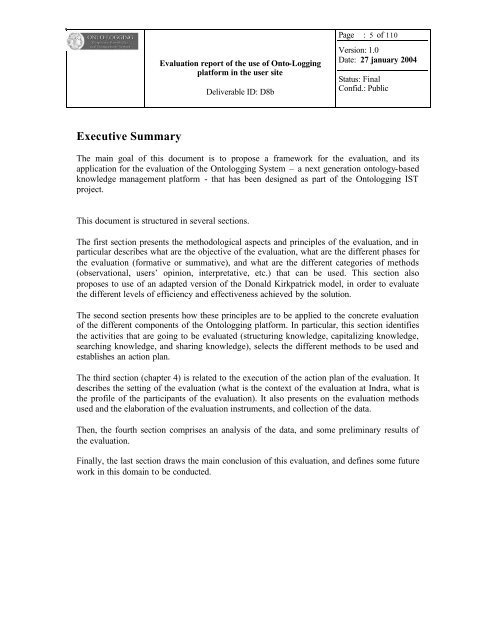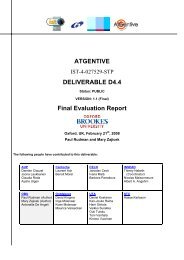pdf 820Kb - INSEAD CALT
pdf 820Kb - INSEAD CALT
pdf 820Kb - INSEAD CALT
You also want an ePaper? Increase the reach of your titles
YUMPU automatically turns print PDFs into web optimized ePapers that Google loves.
Executive Summary<br />
Evaluation report of the use of Onto-Logging<br />
platform in the user site<br />
Deliverable ID: D8b<br />
Page : 5 of 110<br />
Version: 1.0<br />
Date: 27 january 2004<br />
Status: Final<br />
Confid.: Public<br />
The main goal of this document is to propose a framework for the evaluation, and its<br />
application for the evaluation of the Ontologging System – a next generation ontology-based<br />
knowledge management platform - that has been designed as part of the Ontologging IST<br />
project.<br />
This document is structured in several sections.<br />
The first section presents the methodological aspects and principles of the evaluation, and in<br />
particular describes what are the objective of the evaluation, what are the different phases for<br />
the evaluation (formative or summative), and what are the different categories of methods<br />
(observational, users’ opinion, interpretative, etc.) that can be used. This section also<br />
proposes to use of an adapted version of the Donald Kirkpatrick model, in order to evaluate<br />
the different levels of efficiency and effectiveness achieved by the solution.<br />
The second section presents how these principles are to be applied to the concrete evaluation<br />
of the different components of the Ontologging platform. In particular, this section identifies<br />
the activities that are going to be evaluated (structuring knowledge, capitalizing knowledge,<br />
searching knowledge, and sharing knowledge), selects the different methods to be used and<br />
establishes an action plan.<br />
The third section (chapter 4) is related to the execution of the action plan of the evaluation. It<br />
describes the setting of the evaluation (what is the context of the evaluation at Indra, what is<br />
the profile of the participants of the evaluation). It also presents on the evaluation methods<br />
used and the elaboration of the evaluation instruments, and collection of the data.<br />
Then, the fourth section comprises an analysis of the data, and some preliminary results of<br />
the evaluation.<br />
Finally, the last section draws the main conclusion of this evaluation, and defines some future<br />
work in this domain to be conducted.
















